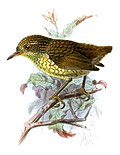| Syndactyla | |
|---|---|
 | |
| Buff-browed foliage-gleaner (Syndactyla rufosuperciliata) | |
| Scientific classification | |
| Kingdom: | Animalia |
| Phylum: | Chordata |
| Class: | Aves |
| Order: | Passeriformes |
| Family: | Furnariidae |
| Genus: | Syndactyla Reichenbach, 1853 |
| Type species | |
| Xenops rufosuperciliatus Buff-browed foliage-gleaner Lafresnaye, 1832 | |
| Species | |
See text | |
Syndactyla is a genus of foliage-gleaners, birds in the ovenbird family Furnariidae. It now includes the two recurvebills.
Contents
The recurvebills are restricted to humid forests in the South American countries of Bolivia, Peru and Brazil. Their common name refers to the peculiar bill-shape, which, at least in the case of the larger-billed Peruvian recurvebill, is an adaption for manipulating bamboo stems. Both species are overall rufescent brown. The SACC reclassified the recurvebills from the genus Simoxenops to Syndactyla based on studies from Dewberry (2011).
